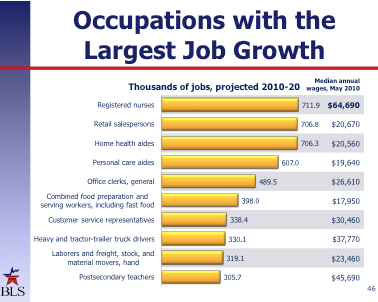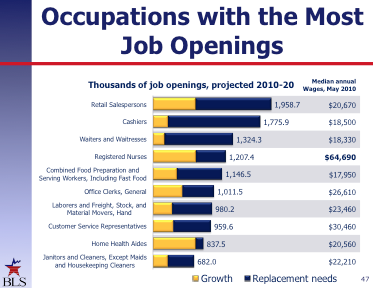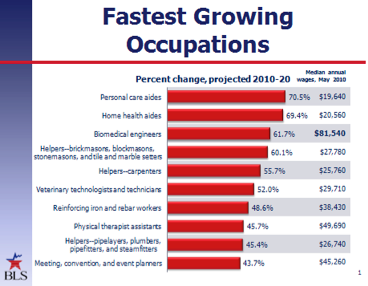The U.S. Bureau of Labor Statistics (BLS) has released its 10 year employment projections, covering the years 2010-2020. These projections show us, once again, that despite the focus on “knowledge economy” occupations, these “knowledge economy” occupations with a few exceptions (notably Registered nurses) are not projected among the main job generators.
As with previous BLS projections, these recently released projections contain a wealth of information about economic growth, labor force participation, and industry growth, both of the recent past and looking to the future. Our San Francisco-based BLS regional commissioner, Mr. Richard Holden, helps us identify some of the main points.
 In 2001, BLS projected that total nonfarm payroll employment would reach 152 million jobs by 2010—up from 130.6 million in 2000. Instead, due primarily to the job destruction of the Great Recession, total nonfarm payroll employment stood at 130.4 million in 2010. In its latest projections, BLS now projects payroll employment to reach 150.2 million by 2020.
In 2001, BLS projected that total nonfarm payroll employment would reach 152 million jobs by 2010—up from 130.6 million in 2000. Instead, due primarily to the job destruction of the Great Recession, total nonfarm payroll employment stood at 130.4 million in 2010. In its latest projections, BLS now projects payroll employment to reach 150.2 million by 2020.
Among the projections, three charts on occupational growth stand out. The first chart below shows the occupations with the largest projected job growth, 2010-2020.
Among these top ten occupations, only one, Registered nurses, has a median annual wage of above $50,000; and only two, Registered Nurses and Postsecondary Teachers, require a bachelor’s degree or above. The other eight occupations do not require a bachelor’s degree.
This second chart shows the occupations with the largest absolute job growth.
This chart is even more weighted toward lower wage occupations, and only one of these occupations in the top ten (Registered Nurses) requires a college degree or beyond.
The third chart is the fastest growing occupations.
In this chart, knowledge economy jobs are little more prominent: Biomedical engineers and Veterinary technologists/technicians make the top ten. But even among these fast growing occupations, eight of ten are occupations not requiring a bachelor’s degree.
The issue of education and occupations is more complex than formal degree requirements. A wide variety of occupations considered non knowledge economy job, such as auto technician, HVAC technician and office technician, require mastery of technical skills, not required in previous decades. Further, jobs such as personal care aides and home health aides require health care knowledge and expertise not required in previous decades.
But the main point remains from these projections: most jobs in the emerging economy are not ones requiring college degrees or above. This point is underlined by a chart on “Employment and total job openings by education, work experience, and on-the-job training category” that is included in the BLS projections. BLS finds that in 2010 that only 20% of jobs required a bachelor’s degree or above. Another 5.6% required an Associate’s degree, 4.6% required a post-secondary non-degree award, and .6% required some college, no degree. Fully 69.3% of occupations required a high school degree at most.
For 2020, BLS projects these percentages will not change significantly. The 2020 projections are for 20.5% of jobs to require a bachelor’s degree or above, another 5.8% of jobs to require an Associate’s degree, and 68.3% of jobs to require a high school degree or less.
We cannot all be software engineers, or biotech scientists or alternative energy technicians. As I have argued in previous postings on California’s job projections , how we individually and as a society approach the non-knowledge jobs will be a central challenge of the emerging economy.




